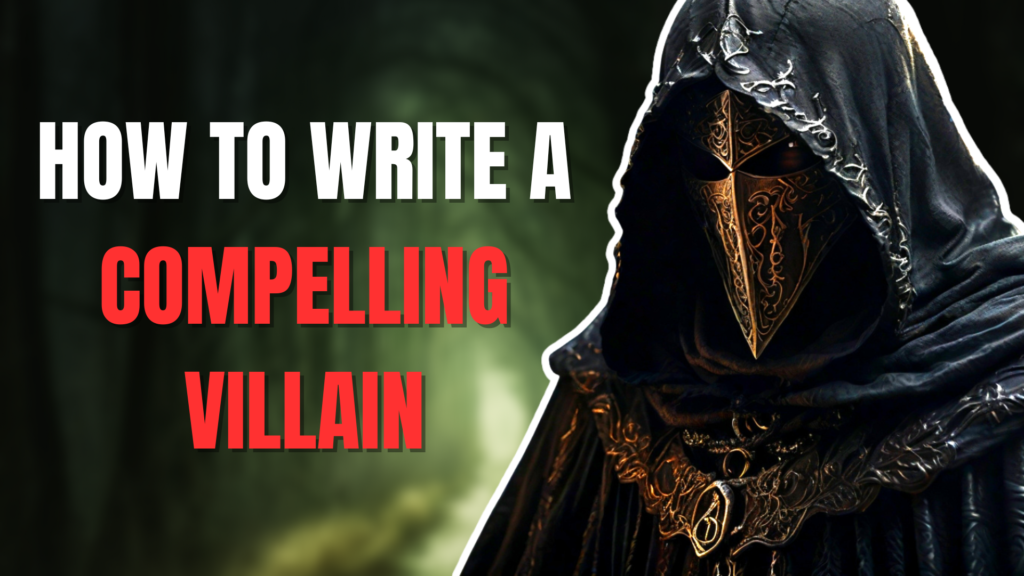Villains are typically some of the most popular characters in fiction stories. I bet you, even if someone hasn’t even seen Star Wars, they already know what Darth Vader looks like or who Darth Vader is. Think of Sauron from The Lord of the Rings. Or Joker from Batman. How about Voldemort from Harry Potter? There are so many memorable and well-known villains from literature, games, and film out there that I could write essays about how many there are. But why do we know and love these villains so much? What makes a compelling villain, and how can you even properly write a compelling villain?
What is a Villain?
This seems like a bit of a silly question to ask, because we all technically know what a villain is, but there’s a bit of nuance to this question. You see, we often think the villain is simply the antagonist of the story. Essentially, just the opposing force to the protagonist, or main character. That’s not necessarily true.
Your villain can simultaneously be the protagonist if you choose to make your main character the villain. At the end of the day though, the idea of the villain is a character who commits evil actions for whatever reasons and whatever motivations.
There are many types of villains like the tragic villains or the morally gray heroes who technically fall into villain-behavior or even the supervillain (which is just a really evil guy for the sake of being really evil).
A villain is pretty much someone who engages in negative forms of behavior that is typically not something a hero would engage in. The villain does not shy away from doing things that are “bad.” They are usually depicted as being the opposing force to the hero or protagonist and in the most traditional sense, they are usually the antagonists.
How to Write a Compelling Villain
To write a compelling villain, you need to approach the writing process as though you were writing a good character in the first place. So, with that in mind…
1. Complex Motivations
A good villain needs complex motivations in order to be interesting and memorable. A one-dimensional villain can be quite forgettable because why would anyone care about this villain if they’re just muhuhahaha bad guy types? Even if you’re writing a purely evil villain who is just evil, there’s ways to do that (hint, hint: check out my guide on that!).
In order to make an interesting and compelling villain, delve into the motivations behind their actions. What is driving your villain to oppose the hero/good guy type of the story? Does the villain have some sort of underlying trauma? Is the villain just a power-hungry monster? Is the villain on the opposite end of an ideological or political spectrum? Make sure these things are known!
2. Humanize the Villain
I know, you’re probably wondering how you can humanize a character that’s meant to be some type of bad guy. Well, humanizing the villain can actually work in your benefit as a writer. Show how the villain reacts in human ways to things, such as fear and doubt. The villain will then feel more well-rounded and realistic, and it will cause the readers to empathize or even sympathize with them. This sounds crazy and maybe you don’t think it’ll work, but just because the character is portrayed as a villain doesn’t mean they’re devoid of any humanity.
Try out Scrivener today for free and see why authors absolutely love it!
Take Walter White from Breaking Bad: he’s a villain at the end of the day because he’s literally cooking and selling meth. But, he’s portrayed in a human way where the viewers of Breaking Bad can even empathize with Walter White and understand that his motivation was to pay for his cancer treatment (or was it???).
3. Give the Villain a Good Backstory
The backstory of the villain is a very important element of the villain’s construction. Aside from the motivations, what propelled those motivations in the first place? What sort of events shaped their worldview? What moments in their lives caused them to become such villainous people?
An in-depth backstory will help make your readers more understanding of your villain’s actions and potentially even feel some level of forgiveness for the villain.
4. Unique Characteristics are Important!
To make your villain more well-rounded, you can give them distinct and interesting qualities that define them and give them more depth. These things can be like a unique speech pattern or a memorable physical trait (Voldemort’s noseless state, for example). A villain must be recognizable and engaging, and giving them something unique can help add onto that.
5. Moral Ambiguity Helps Too
Morally ambiguous villains can help really change the perspective of the readers. A villain who believes their actions are justified in the name of the greater good or a villain that doesn’t even realize they’re the villain can help to really shape the story. It can make readers think more in-depth as the villain cna challenge the concept of what is morally righteous and what isn’t.
6. The Villain Must be a Credible Threat
The villain in your story can’t just be something small or silly. The villain needs to pose a genuine and credible threat and opposition to your protagonist. Why is your villain a villain is one thing, but how your villain is a villain is another thing. If your hero is just super strong the entire time and can’t be beaten, then what’s the point of your villain? A hero can be strong, but the villain needs to be stronger. The villain needs to be a challenging force for the hero.
7. Give Your Villain Some Evolution
A villain–unless they’re maybe some metaphysical Satan-type figure–will likely undergo some sort of evolution. The villain can discover new things or undergo some sort of changes to their motivations. This doesn’t necessarily work for all villains, so use this with caution. But it can be really interesting for the readers to see how the villain may change as the story progresses.
Get amazing discounts on select Microsoft laptops today!
Villains can be some of the best and most well-written characters you can include in your story and writing a compelling villain is very important. A villain can really elevate your story and allow for your readers to connect more to the core of your book. Additionally, writing a compelling villain can make your readers interested and engaged in the villain’s story, which takes your story to a whole different level.
Before you go, don’t forget to check out my series, The Fallen Age Saga. You can buy the books over on Amazon!

